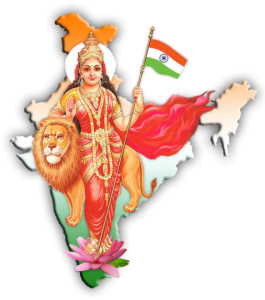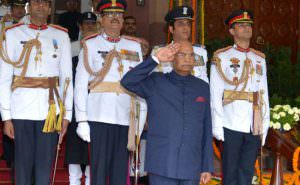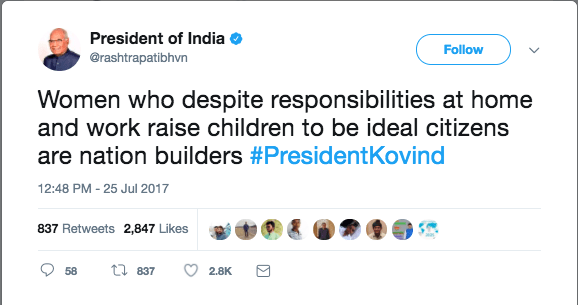Ram Nath Kovind was sworn in as the 14th President of India yesterday morning, after being elected with a majority by members of parliament. While some people are celebrating his victory as a victory for Dalits, others are quick to point out his roots in the Brahmanical Hindu nationalist organization, the Rashtriya Swayamsevak Sangh (RSS). On his first day of being president he tweeted this:
Women who despite responsibilities at home and work raise children to be ideal citizens are nation builders #PresidentKovind
— President of India (@rashtrapatibhvn) July 25, 2017
While seemingly innocent, President Kovind’s tweet plays into harmful stereotypes of what Indian women are supposed to be, with many people replying in the comments with approval. Kovind’s intent is not empowering women at all. It’s easy to fall into this trap, as he is seemingly praising women. But is there any more depth to this comment other than seeing women as giving birth to and taking care of more loyal citizens?
Kovind’s intent is not empowering to women at all.
Women being seen as the teachers and carriers of national honour is a disturbingly common sentiment in India. People like Kovind see the home as one of the spaces where young people first learn patriotism and since the entire weight of managing the house hold comes onto women, it becomes their responsibility.
While Kovind mentions women who “work” to pay regards to working women, he still keeps his focus on women’s domestic responsibilities. Men aren’t usually given credit for going to work and managing a household because they clearly don’t have the time to nurture and breed nation-builders – women are expected to do all of that.
Work such as childcare and “responsibilities at home” are automatically delegated to women. This work isn’t valued under capitalism with a salary hikes and job benefits but is expected to happen anyway for the smooth functioning of capitalistic structures. It’s because this work doesn’t get any importance, that it seems easy for a woman to do all of it.
Work such as childcare and “responsibilities at home” are automatically delegated to women.
“Responsibilities at home”, as Kovind puts it, doesn’t come close to talking about the physical labour, mental and emotional abuse, and sometimes violence Indian women have to face in their own homes. Despite this, they must find the time to teach their children patriotism.
Also Read: House Work? What’s That? Caregiving and (Un)Paid Work
Women being seen as “nation-builders” is a theme that has run through the country’s history since Independence. The bodies of Indian women are where the honour of the nation is situated, and thus policing the activities of Indian women becomes a matter of national importance.
Women are meant to be modest and protect their honour by performing their gender in ways deemed appropriate by men, which explains the use of curses and threats that surround someone’s mother’s, sister’s, or wife’s honour. Women need to maintain this status and teach their children the same. We cannot be imagined outside our relation to men or children. In the correct performance of our femininity, as domesticated wives and mothers, we become the ideal citizen, and spawn more ideal citizens.
The focus of women as the flag-bearers of nationalism comes with the deification of women. In the commonly used phrase and conservative dog-whistle “Bharat Mata ki Jai” (Victory for Mother India), the nation is seen as a maternal goddess. The land is a woman and a mother, she will give birth to sons and care for you, but yet you can also loot her, use her for profit, and buy her.
Also Read: Bharat Mata and the Ideal Indian Woman

Bharat Mata as imagined as a Hindu woman
This symbolism also places the state into a specific Hindu context, as minority religions do not see their cultural markers on the body of Bharat Mata, which then reserves as a reminder that the land itself is seen as Hindu.
There is a specific type of woman that is most valuable to the Indian state, and that is the woman that they have chosen to be the face of Bharat Mata – a light-skinned, upper-caste, Hindu woman who practices “modesty”, which means she gets married, bears children, and doesn’t speak up. This is the woman the BJP/RSS imagines as the torch of a Hindu state, encompassing an ideal Hindu (and therefore Indian) femininity.
There is a specific type of woman who is valuable to the state, and she’s the woman they’ve chosen as the face of Bharat Mata.
When people imagine the state as a woman, it allows them to imagine a woman as a state – something that needs to be protected, can be invaded, and can be used for profit. This only further goes to dehumanize women.
It’s easy to speak of dehumanization as only seeing something as less than human, but this BJP/RSS backed ideology places upper-caste Hindu women as above human and deified. This is also why people place honour in women, because they imagine her as a state, something they are used to placing nationalistic honour in.
What about those women who are dehumanized to be seen as lesser? Women who do not fit the carefully selected criteria of Bharat Mata? They are then forced to mimic as many of these ideals as they can, to gain closer proximity to acceptance by the state.
So, Kovind’s tweet isn’t just a throwaway compliment for his women voting block, but it is the uplifting of an old framework that pigeonholes women in claustrophobic boxes to propagate some nationalist cause.
Thus, what implication does Kovind’s comment on women and “nation-building” have on citizens of India? His ideology reinforces the view of women in the way they have been historically used, as moral compasses that hold national honour.
In his inaugural address, he referenced building an “India of our dreams”. The question that follows is – whose dream India are we building? And how do those people envision Indian women in their dream?

Ram Nath Kovind being sworn in as President. Image via: NDTV
whose dream India are we building? And how do those people envision Indian women in their dream?
It’s important to be aware of the subtle ways in which the government tries to dictate how women should best perform their gender – not necessarily for your own benefit but for the benefit of the state.
About the author(s)
Jasveen is currently a student at the New School studying poetry, race and ethnicity, and gender studies. You can find her either in New Delhi or New York. She's interested in gender justice, religion, diverse art, and class reform. Her twitter is: @jasveenflies





I am a woman and I disagree with you…..
Such a well written article???